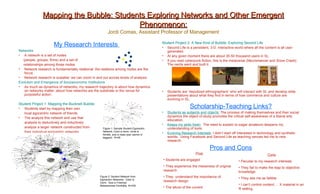Maping The Bubble Poster (Comas)
- 1. Mapping the Bubble: Students Exploring Networks and Other Emergent Phenomenon: Jordi Comas, Assistant Professor of Management My Research Interests Networks A network is a set of nodes (people, groups, firms) and a set of relationships among those nodes. Network research is fundamentally relational: the relations among nodes are the focus. Network research is scalable: we can zoom in and out across levels of analysis Evolution and Emergence of Socioeconomic Institutions As much as dynamics of networks, my research trajectory is about how dynamics on networks matter, about how networks are the substrate or the venue for purposeful action. Student Project 1: Mapping the Bucknell Bubble Students start by mapping their own local egocentric network of friends. The analyze this network and use that analysis to deductively and inductively analyze a larger network constructed from their individual egocentric networks. Student Project 2: A New Kind of Bubble: Exploring Second Life Second Life is a persistent, 3-D, interactive world where all the content is all user-generated. At any given moment there are about 35-50 thousand users in SL. If you read cyberpunk fiction, this is the metaverse (Neuromancer and Snow Crash). The nerds went and built it. Students are ŌĆ£deputized ethnographersŌĆØ who will interact with SL and develop slide presentations about what they find in terms of how commerce and culture are evolving in SL. Scholarship-Teaching Links? Students as subjects and objects: The process of making themselves and their social dynamics the object of study promotes the critical self-awareness of a liberal arts education. Keeps my skills fresh: The need to explain to eager amateurs deepens my understanding of tools. Evolving Research Interests : I didnŌĆÖt start off interested in technology and synthetic worlds. Using Facebook and Second Life as teaching venues led me to new research. Pros and Cons Figure 1: Sample Student Egocentric Network; Color is dorm, circle is female, size is class year (senior is biggest). N=49 Figure 2: Student Network from Egocentric Networks. Color is Dorm. Size is Freeman Betweenness Centrality. N=430 Pros Students are engaged They experience the messiness of original research They understand the importance of research design The allure of the current Cons Peculiar to my research interests They fail to make the leap to objective knowledge They see me as fallible I canŌĆÖt control contentŌĆ” X material in an R setting.

